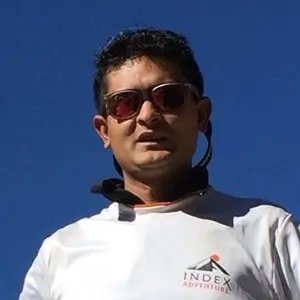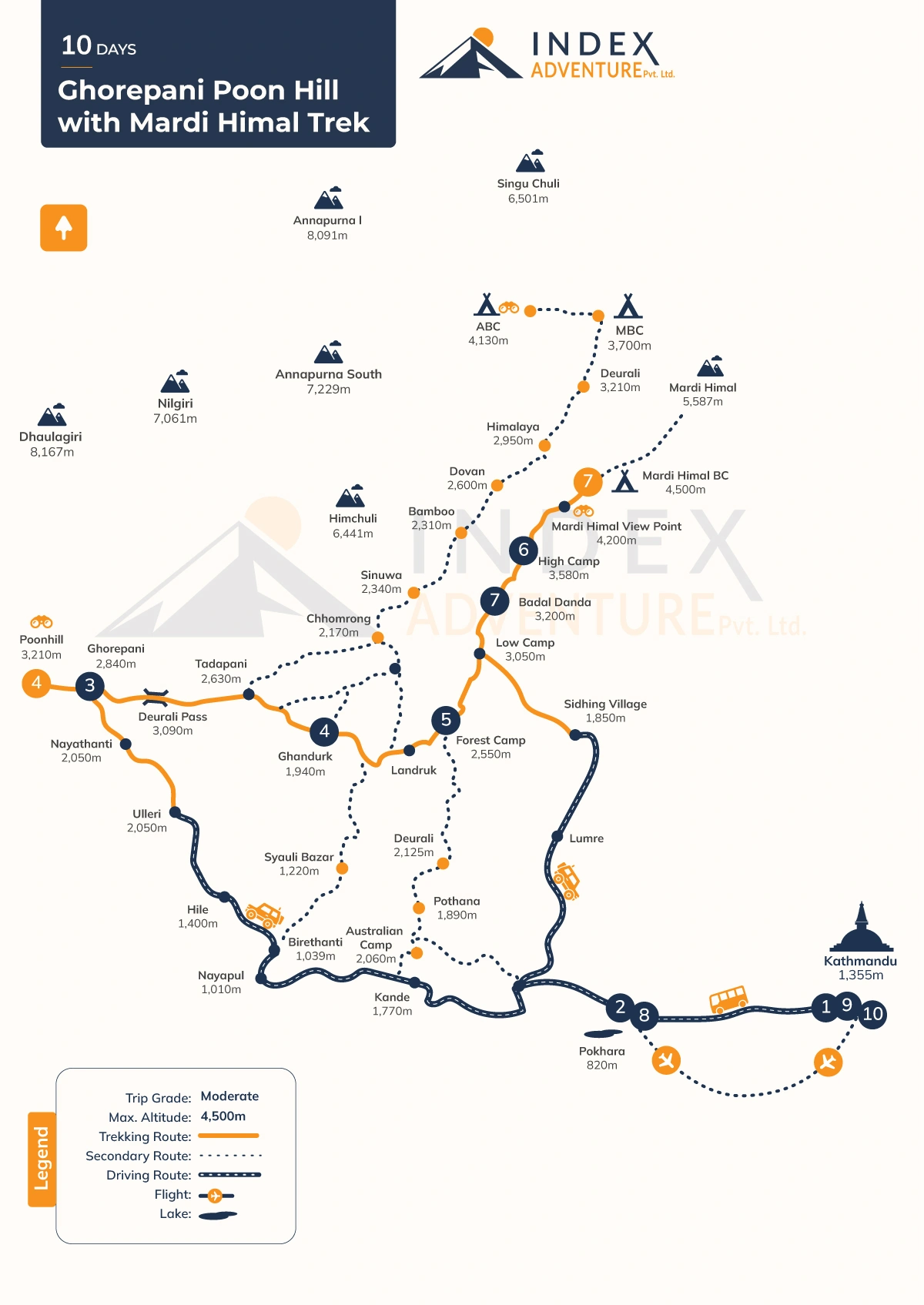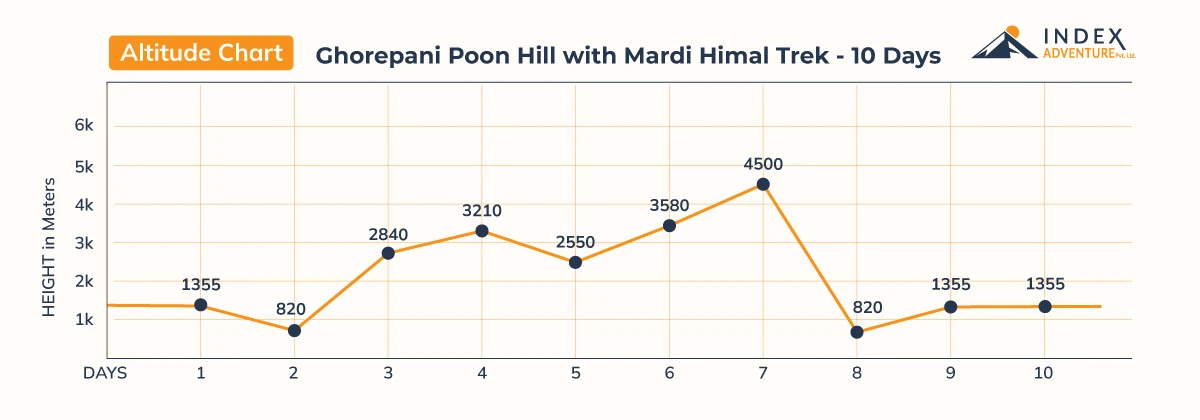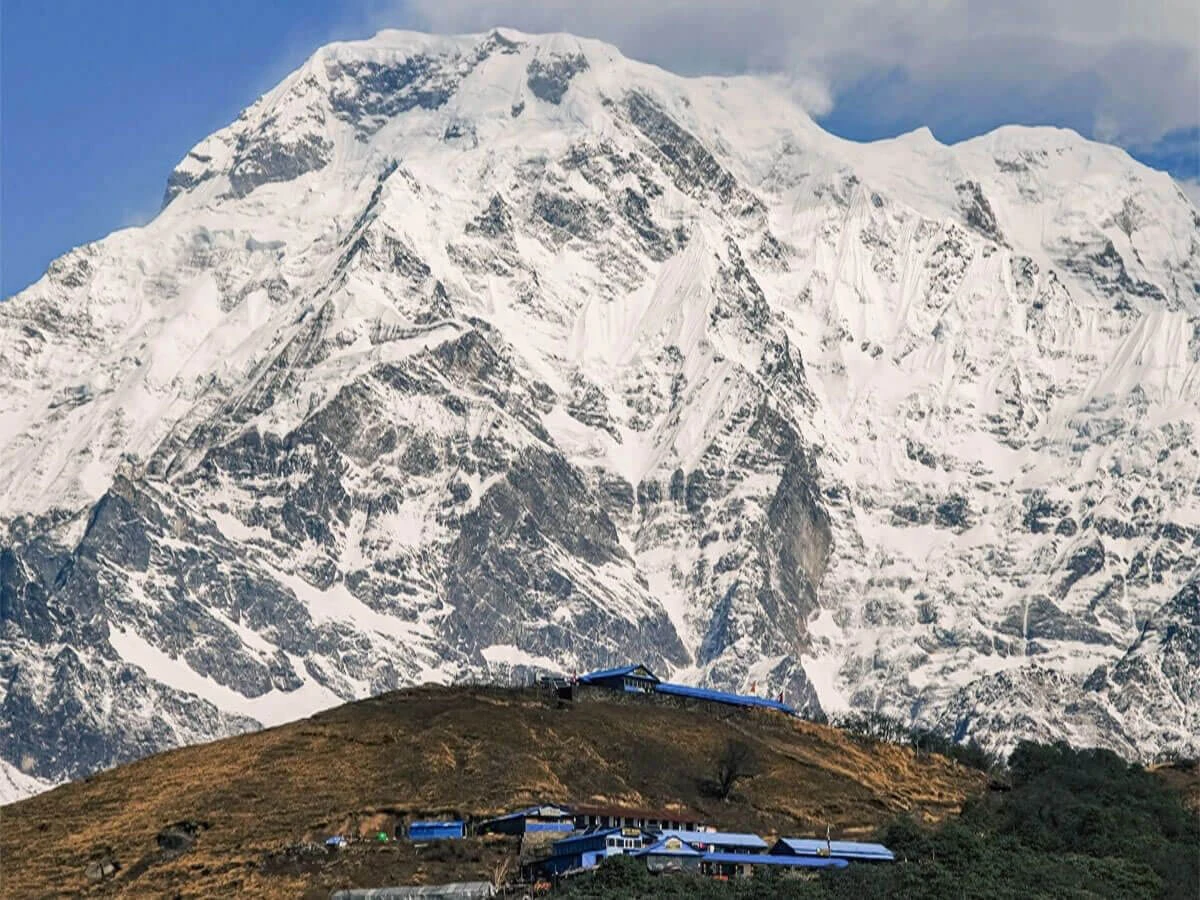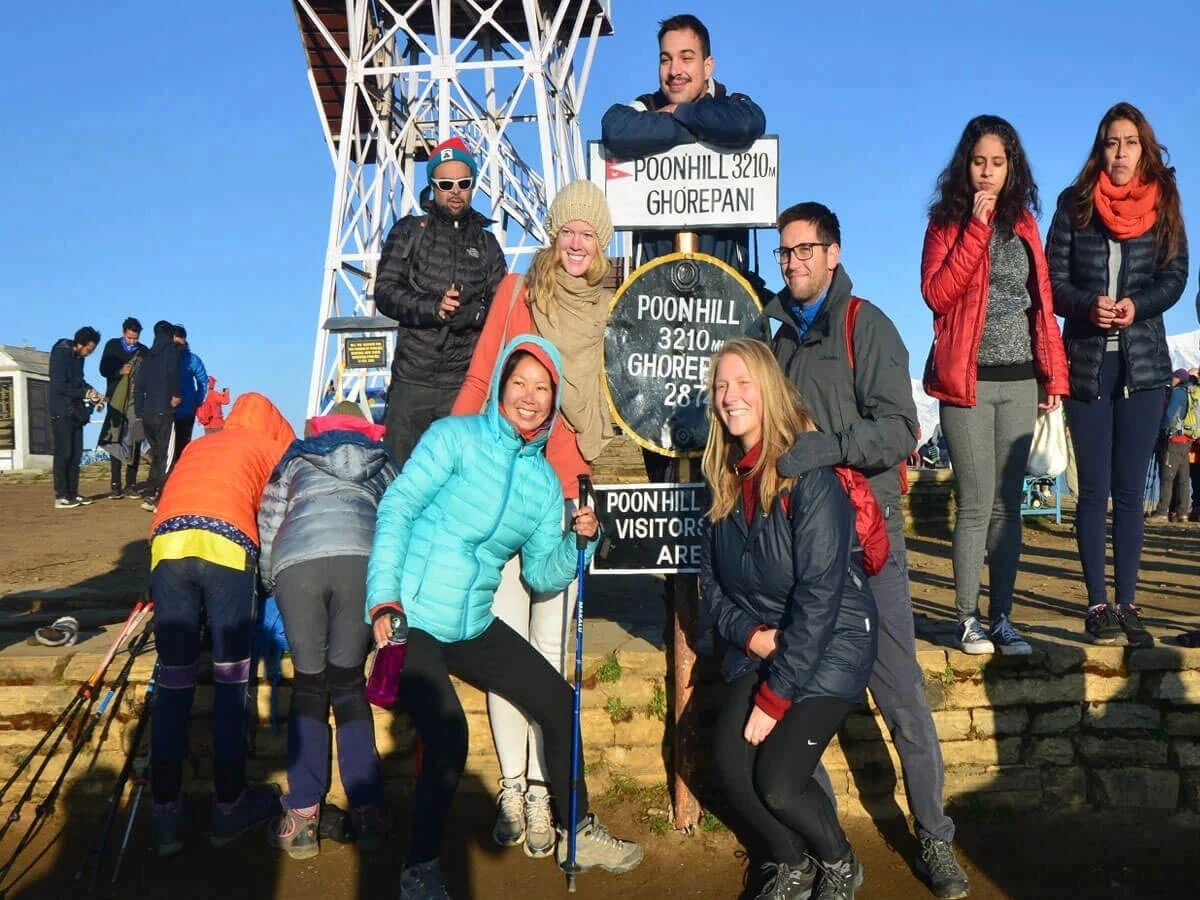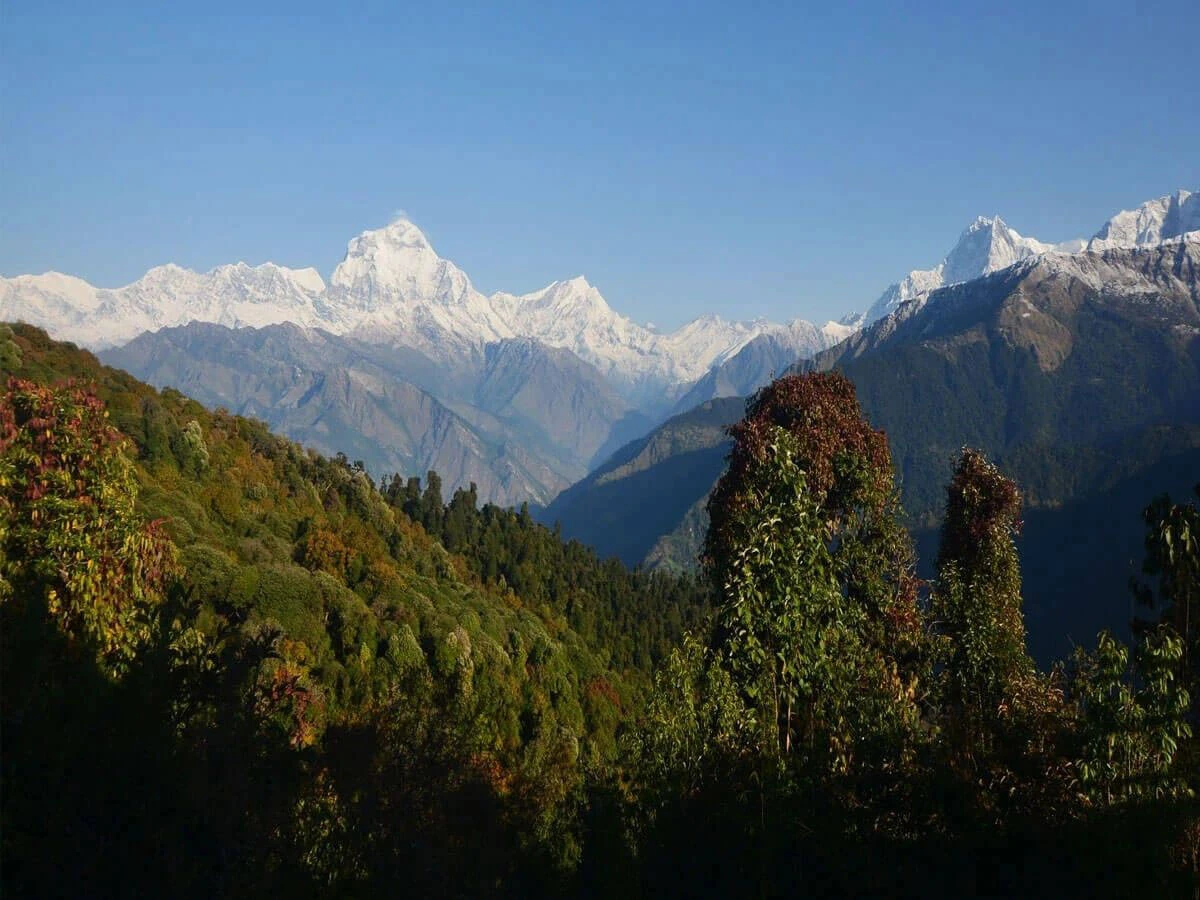The Ghorepani Poon Hill with Mardi Himal 10-day Trek is a peaceful journey into the heart of the Annapurna region. You will trek to two of the most enticing short-duration destinations in a short span. This trek further provides insights into the local Micx Cast of Gurung and Magar, Brahmins & Chhetris communities' lifestyles, cultures, and traditions.
The trek is divided into two parts. First, you will go on a leisurely hike to Poon Hill. Your journey will pass through rhododendron forests, terraced fields, and traditional villages. You will experience the unique Himalayan culture and embrace the warm hospitality of the local communities of the Pun Magar settlement of the Village as you travel from one destination to another.
The highlight of the Ghorepani Poon Hill Trek is the early morning trek to Poon Hill ( 3,210 m) View Point. The Ghorepani Poon Hill offers stunning views of Annapurna South(7,219m), Dhaulagiri(8,167m), Nilgiri (7061 m), Machhapuchhare (6,993m), Himchuli(6,441m), and many other mountains.
After completing the 3210-meter Poon Hill ascent, the trek to Mardi Himal offers a perfect blend of adventure, natural beauty, and cultural immersion, making it the best choice for both beginners and seasoned trekkers. You'll experience breathtaking views of the Himalayas, diverse landscapes, and the warm hospitality of rural Nepali villages. where you can find solace and serenity amid the cool Himalayan breeze. The trek also provides dramatic views of Machhapuchhre, Annapurna South, and Hiunchuli. From the Mardi Himal Base Camp, you can have a very close view of Mount Fishtail with Golden colors.
Highlights of the Ghorepani Poon Hill and Mardi Himal Trek
- Watching the sunrise view from Poon Hill (3.210 M).
- Sunrise vistas from the viewpoint of Mardi Himal base Camp ( 4,500 M).
- Relish the panoramic views from Poonhill Annapurna range, the Dhaulagiri range, Machhapuchhre, and Hiunchuli.
- Exploring beautiful villages like Ghorepani, Ghandruk, Landruk & Siding.
- Enjoy the warm hospitality of the Local Cast of Mix from Culture Brahmins, Chhetris, Gurung & Magar (Pun)communities.
- Walk through rhododendron forests, Pine, flora, and fauna, with spot wildlife.
Why Go on the Ghorepani Poon Hill and Mardi Himal Trek?
The Ghorepani Poon Hill and Mardi Himal trek harmoniously mixes natural beauty, cultural encounters, and adventure on a 10-day journey, promising unforgettable memories in the heart of the Annapurna region. Here are some of the reasons to embark on this incredible journey:
Relish the Diverse Landscape: The Ghorepani Poon Hill and Mardi Himal trek takes you through beautiful routes in the Annapurna region. These trails are known for their breathtaking landscapes and unique terrains.
As you trek to Mardi Himal Base Camp, you will find amazing high-altitude ridges and rocky paths. Likewise, Ghorepani Poon Hill is known for its lush forests, terraced farmlands, and hills. If you're traveling in spring, you will find rhododendrons and wildflower blossoms adding beauty to the region.
Sunrise View from Poon Hill: Poon Hill is one of the most famous viewpoints in Nepal. This destination is known for its sunrise view over the Annapurna and Dhaulagiri ranges in different hues of gold.
Cultural Immersion in Magar and Gurung Villages: The Ghorepani Poon Hill and Mardi Himal consist of the ethnic Magar and Gurung communities of the Annapurna Region. During the trek, you can experience their unique culture and experience warm hospitality.
Close-up Views of Majestic Peaks: The Mardi Base Camp Trek takes you up close to the majestic Annapurna and Dhaulagiri ranges. While you get occasional views of the icy giants during your trek, you can get an immersive view of peaks like Machhapuchhre from the Mardi Himal Base Camp. You will also find a beautiful panorama of the mighty Annapurna and Dhaulagiri.
A Blend of Adventure and Comfort: The Ghorepani Poon Hill and Mardi Base Camp mix adventure and comfort. This trek takes you through the adventurous forest routes, narrow alpine ridges, and rugged Himalayan terrain. But you can expect comfort, as you will also find plenty of rest stops and modern tea houses along the way.
Best Time for Ghorepani Poon Hill with Mardi Himal Trek for 2025 and 2026
Spring (March to June ) is an ideal choice for trekking to Ghorepani Poon Hill and Mardi Himal Base Camp. During these months, the temperatures are warm & comfortable, with clear mornings. You will find most of the trails adorned with blossoming rhododendron flowers.
The Ghorepani Poon Hill and Mardi Himal trek is also an excellent choice if you’re traveling in autumn (September to December). You will find clear skies offering stunning mountain views, and harvesting time is nice to see the green landscape. The weather is stable, with less chance of rainfall, with totally clear of Himalays without clouds.
Likewise, if you’re looking to trek and avoid the peak season crowd, winter (January to February) is the most suitable. During these months, you will find fewer crowds. You can enjoy the clear mountain views, but the temperatures may drop significantly in higher elevations with snowfall & and cold weather temperatures.
Monsoon (June to August) is the least favorable time to trek to Ghorepani Poon Hill and Mardi Hill. Due to heavy rainfall, major highways face disruptions. Additionally, the trails in the Himalayas are slippery. This significantly increases the chances of accidents.
The Himalayas have been experiencing a shift in seasonal patterns in recent years due to global warming, causing unpredictable weather conditions. Therefore, we recommend checking the weather or consulting with our expert guides before booking your Ghorepani Poon Hill with Mardi Himal Trek.
10-Day Ghorepani Poon Hill and Mardi Himal Trekking Permits
You will need the following permits while trekking to Ghorepani Poon Hill and Mardi Himal.
Annapurna Conservation Area Project (ACAP) Permit: Ghorepani Poon Hill and Mardi Himal fall under the ACAP region. You need an ACAP permit to explore the area, which can be collected from the National Trust for Nature Conservation (NTNC) office in Kathmandu or Pokhara.
Trekkers' Information Management System (TIMS) Card: The TIMS card is a mandatory permit for the Ghorepani Poon Hill and Mardi Himal Trek. You can get the TIMS card at the Nepal Tourism Board Office in Kathmandu or Pokhara.
Avoid the hassle of queuing for your permits. Book your Ghorepani Poon Hill and Mardi Himal adventure with Index Adventure. We secure both permits before your trek.
Ghorepani Poon Hill and Mardi Himal Trekking: Costs for Transportation, Guides, and Porters
The Ghorepani Poon Hill with Mardi Himal trek costs can vary based on the trekkers' preferences. Several factors cause the overall prices to change. For example number of trekking days, the number of trek participants, additional porter requirements, luxury options, and additional expenses during the trek are some of the key contributors to the trek expenses.
For the standard price of the Ghorepani Poon Hill and Mardi Himal trek, check our fixed departure treks. Our standard trek packages include transportation costs, permits, a guide, and meals during the trek. We recommend you carry extra cash for additional expenses, emergencies, and tips.
Customized Ghorepani Poon Hill with Mardi Himal Trekking for 2025 and 2026
Contact our expert guides if you want to extend your trek or require additional services. We are experts in crafting reasonable trekking packages tailored to your preferences and requirements.
Contact us to create a customized Ghorepani Poon Hill and Mardi Himal trek package for 2025 and 2026. Together, we can create a once-in-a-lifetime adventure that exceeds your expectations.

